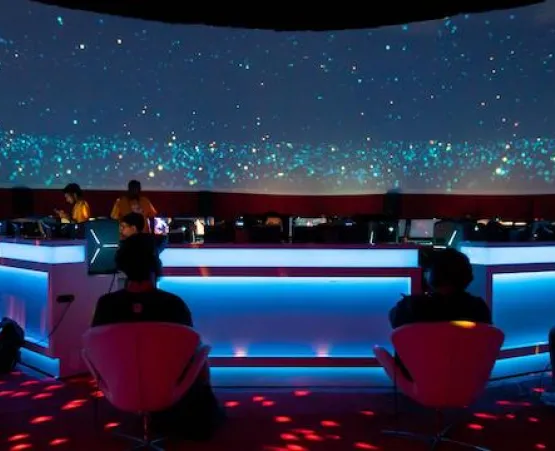Written by Yangos Hadjiyannis, with contributions from the rest of the team.
For the past few years, a team of MDM students and alumni have collaborated to build the VR Theater at SIGGRAPH.
The VR Theater has become one of the main pillars of SIGGRAPH (one of the premier technology conferences in the world on computer graphics and interactive techniques) and is a chance for attendees to experience some of the world’s top narrative-driven VR films within a unique group setting.
The VR Theater that was created for SIGGRAPH 2019 in LA this summer was a continuation of the VR Theater that took place in Vancouver for SIGGRAPH 2018.
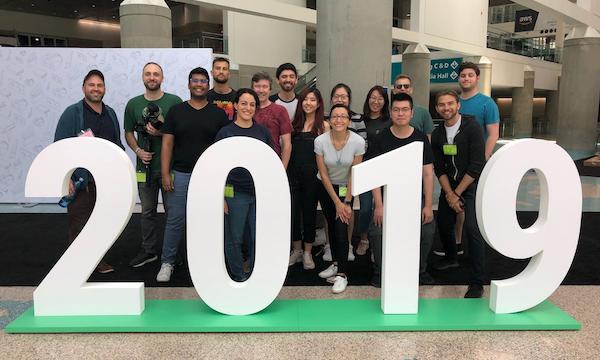
From left to right: Yangos Hadjiyannis (C1), Andreas Psaltis, Thoufeeq Ahamed (C12), Marco Cermusoni (C11), Monica Cappiello, John Gwinner, Mateo Cano (C11), Sherry Li + Yao Wang (ICTUS Audio), Maria Herrera (C11), Youhan Guan (C11), Conrad Sly (C11), Jimmz Zhang (C11), Maxwell Planck and Carlos Diaz-Padron.
This world-class location-specific experiences were created by a team mostly comprised of MDM alumni, students and faculty members, including Conrad Sly, Jimmz Zhang, Marco Cermusoni, Maria Herrera, Mateo Cano, Thoufeeq Ahamed and Youhan Guan.
The project was also supported by the CDM with faculty mentors Larry Bafia and Patrick Pennefather and the invaluable sponsorship of Richard Smith and the GNW Trust.
Under the guidance of Maxwell Planck, the project took a year to pull together and resulted in a networked, 54 seat theater with a 270-degree cycloramic screen that packaged in 50 min shows that were the best in VR narrative and immersive storytelling. The alumni team worked vigorously in nailing down all aspects of the experience, from logistics to UX to developing the in-headset lobby experience.
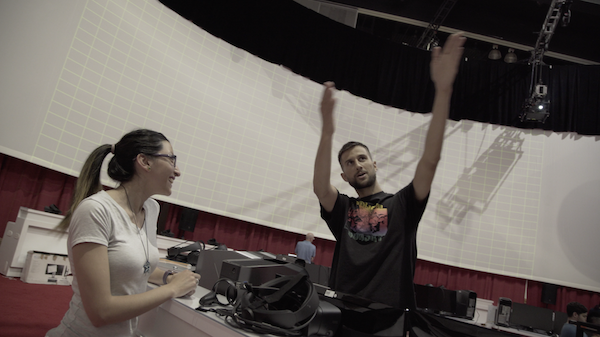
The theater’s ability to introduce VR to large groups of people in a togethered experience, was unprecedented. 10,485 narrative VR experiences were served to about 2,385 people (about 12% of the total conference attendees) in 4.5 days, making it possibly one of the largest location-based narrative VR experiences on the planet for that duration.
Based on what the team has learned building the VR Theater, these are the Key Components to a Successful VR Theater Experience:
Lights, Sound, Action and Flow
The show began with people entering the immersive space surrounded by gorgeous projections of a particle ocean and point lighting. Using a dynamic real-time projection system with Touchdesigner, Jimmz Zhang, the team’s projection wizard, changed elements on the fly and could switch the atmosphere on command.
The next step was to elegantly direct human flow so that guests fill in the room. To do so, the team designed spatial binaural sound by ICTUS Audio; wave-like, musical tones would travel in sequence to each of the 10 speaker setups, starting from the entrance to the far end of the room in a way that invited people to fill the room in a cyclical manner. The immersion aspect was dramatically enhanced as soon as the viewers put on sound-isolating headphones and the spatial binaural sound directed the viewer's attention to the narrative areas of interest.
A networked VR lobby experience was designed and developed as a proscenium to the experience. The timing of each phase of the show - each emotional peak and hill - was carefully designed and tested for maximum attention retainment.
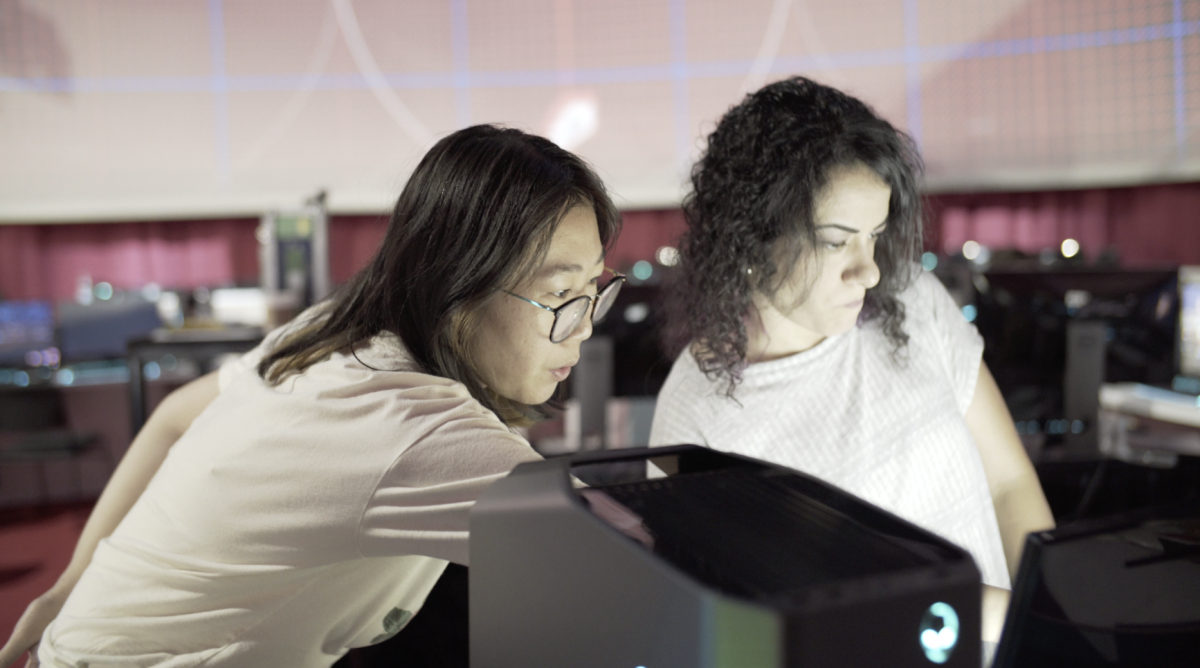
The shared VR lobby invited people to dive into a particle world where they engaged with an interactive playground. They were prompted to interact with a particle ocean, splashing particles at each other. The show began when the audience jointly gathered enough particles into the center to ignite it. The lobby was also designed to guide the audience to familiarize with basic interactions of Oculus controllers by letting them explore freely as visual and audio feedback was provided. This co-located VR lobby experience soothed the audience’s mood and immediately prepared them to jump into the amazing stories ahead.
The Human Factor
People are wary of VR experiences that are isolated. For each of the shows, there was up to 54 people using headsets at the same time. This social aspect allowed people to be themselves and just be immersed in the experience, instead of being isolated or worried about what they looked like. An important factor in creating a memorable experience was the welcoming take off, setup and landing procedures that the trained volunteers assisted with.
The audience stayed immersed in the VR experience for 50 minutes—including people in older age groups and first-time VR users—which is a significant amount of time even for mainstream VR users.
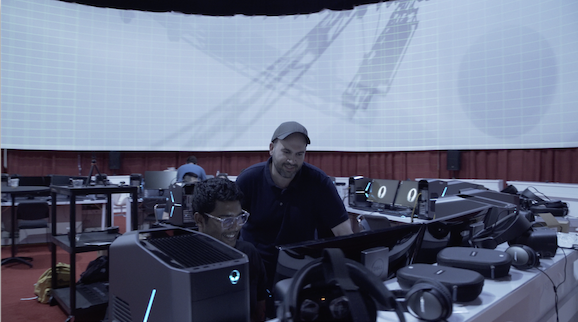
Immersion Persistence
To create the feeling of continuity between the physical and the virtual worlds, the team used visual elements that were persistent between the realities. The in-headset lobby space had the same dimensions and sense of space as the physical one, albeit in a more artistic form. All 54 audience members were transformed into avatars and appeared in the virtual lobby at the same locations related to their actual physical locations, which led to their continued interactions with each other in the virtual dimension.
This shared experience prepared the audience for the VR storytelling content. Five suspended globe lights that formed the SIGGRAPH logo in the VR space were the first thing the audience saw when they removed their headset.
Familiarity, Accessibility and Curation
Another key component to a virtual reality experience is accessibility to a mainstream audience. The team made sure that the space had the familiarity of a traditional theater. Considerations were also made for it to be wheelchair accessible and special attention was given to comfort and hygiene.
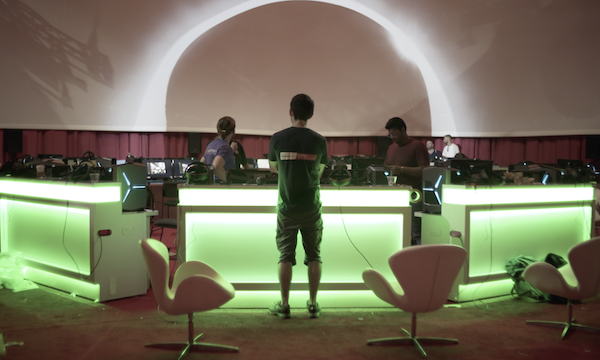
Naturally, the most attention was given to the actual, curated content of the 50-minute show. After a rigorous 17 juror process at the Unity Headquarters in San Francisco and viewing more than 200 VR pieces in a weekend, 5 pieces that demonstrated the greatest in VR techniques and storytelling were selected.
Commitment
This project was only possible due to the immense amount of hours, effort and communication volunteered by all the people who were involved, most of whom also had full-time jobs and obligations. It was a project of shared commitment and ambition with strong CDM ties supporting the quality of the final experience.
Watch a video of the VR Theater:
---
The design of world-class XR experiences continues with a new CDM startup: Kreis Immersive, a startup focused on designing and implementing holistic location-specific experiences.
